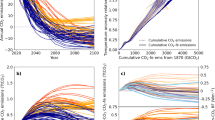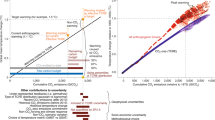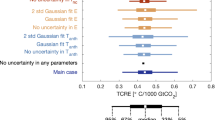Abstract
Several methods exist to estimate the cumulative carbon emissions that would keep global warming to below a given temperature limit. Here we review estimates reported by the IPCC and the recent literature, and discuss the reasons underlying their differences. The most scientifically robust number — the carbon budget for CO2-induced warming only — is also the least relevant for real-world policy. Including all greenhouse gases and using methods based on scenarios that avoid instead of exceed a given temperature limit results in lower carbon budgets. For a >66% chance of limiting warming below the internationally agreed temperature limit of 2 °C relative to pre-industrial levels, the most appropriate carbon budget estimate is 590–1,240 GtCO2 from 2015 onwards. Variations within this range depend on the probability of staying below 2 °C and on end-of-century non-CO2 warming. Current CO2 emissions are about 40 GtCO2 yr−1, and global CO2 emissions thus have to be reduced urgently to keep within a 2 °C-compatible budget.
This is a preview of subscription content, access via your institution
Access options
Subscribe to this journal
Receive 12 print issues and online access
$209.00 per year
only $17.42 per issue
Buy this article
- Purchase on Springer Link
- Instant access to full article PDF
Prices may be subject to local taxes which are calculated during checkout



Similar content being viewed by others
References
United Nations Framework Convention on Climate Change (UN, 1992).
Adoption of the Paris Agreement FCC/CP/2015/L.9/Rev.1 (UNFCCC, 2015).
Andrew, H. M., Kirsten, Z., Reto, K. & Matthews, H. D. Sensitivity of carbon budgets to permafrost carbon feedbacks and non-CO2 forcings. Environ. Res. Lett. 10, 125003 (2015).
Matthews, H. D. & Caldeira, K. Stabilizing climate requires near-zero emissions. Geophys. Res. Lett. 35, L04705 (2008).
Matthews, H. D, Gillett, N. P., Stott, P. A. & Zickfeld, K. The proportionality of global warming to cumulative carbon emissions. Nature 459, 829–832 (2009).
Zickfeld, K., Eby, M., Matthews, H. D. & Weaver, A. J. Setting cumulative emissions targets to reduce the risk of dangerous climate change. Proc. Natl Acad. Sci. USA 106, 16129–16134 (2009).
Meinshausen, M. et al. Greenhouse-gas emission targets for limiting global warming to 2 °C. Nature 458, 1158–1162 (2009).
Allen, M. R. et al. Warming caused by cumulative carbon emissions towards the trillionth tonne. Nature 458, 1163–1166 (2009).
Gillett, N. P., Arora, V. K., Zickfeld, K., Marshall, S. J. & Merryfield, W. J. Ongoing climate change following a complete cessation of carbon dioxide emissions. Nature Geosci. 4, 83–87 (2011).
Gillett, N. P., Arora, V. K., Matthews, D. & Allen, M. R. Constraining the ratio of global warming to cumulative CO2 emissions using CMIP5 simulations. J. Clim. 26, 6844–6858 (2013).
Knutti, R. & Rogelj, J. The legacy of our CO2 emissions: a clash of scientific facts, politics and ethics. Climatic Change 133, 361–373 (2015).
Smith, S. M. et al. Equivalence of greenhouse-gas emissions for peak temperature limits. Nature Clim. Change 2, 535–538 (2012).
Bowerman, N. H. A. et al. The role of short-lived climate pollutants in meeting temperature goals. Nature Clim. Change 3, 1021–1024 (2013).
Rogelj, J. et al. Disentangling the effects of CO2 and short-lived climate forcer mitigation. Proc. Natl Acad. Sci. USA 111, 16325–16330 (2014).
Collins, M. R. et al. in Climate Change 2013: The Physical Science Basis (eds Stocker, T. F. et al.) 1029–1136 (IPCC, Cambridge Univ. Press, 2013).
Frolicher, T. L., Winton, M. & Sarmiento, J. L. Continued global warming after CO2 emissions stoppage. Nature Clim. Change 4, 40–44 (2014).
Mastrandrea, M. D. et al. Guidance Notes for Lead Authors of the IPCC Fifth Assessment Report on Consistent Treatment of Uncertainties 5 (IPCC, 2010).
Zickfel, K., Arora, V. K. & Gillett, N. P. Is the climate response to CO2 emissions path dependent? Geophys. Res. Lett. 39, L05703 (2012).
Van Vuuren, D. P. et al. Temperature increase of 21st century mitigation scenarios. Proc. Natl Acad. Sci. USA 105, 15258–15262 (2008).
Obersteiner, M. et al. Managing climate risk. Science 294, 786–787 (2001).
Azar, C. et al. The feasibility of low CO2 concentration targets and the role of bio-energy with carbon capture and storage (BECCS). Climatic Change 100, 195–202 (2010).
Tavoni, M. & Socolow, R. Modeling meets science and technology: an introduction to a special issue on negative emissions. Climatic Change 118, 1–14 (2013).
Meinshausen, M., Raper, S. C. B. & Wigley, T. M. L. Emulating coupled atmosphere–ocean and carbon cycle models with a simpler model, MAGICC6 – Part 1: Model description and calibration. Atmos. Chem. Phys. 11, 1417–1456 (2011).
Rogelj, J., Meinshausen, M. & Knutti, R. Global warming under old and new scenarios using IPCC climate sensitivity range estimates. Nature Clim. Change 2, 248–253 (2012).
Matthews, H. D., Solomon, S. & Pierrehumbert, R. Cumulative carbon as a policy framework for achieving climate stabilization. Phil. Trans. R. Soc. A 370, 4365–4379 (2012).
IPCC Summary for Policymakers in Climate Change 2013: The Physical Science Basis (eds Stocker, T. F. et al.) 1–29 (Cambridge Univ. Press, 2013).
Clarke, L. et al. International climate policy architectures: overview of the EMF 22 International Scenarios. Energy Econ. 31, S64–S81 (2009).
Riahi, K. et al. in Global Energy Assessment—Toward a Sustainable Future (eds Johansson, T. B., Patwardhan, A., Nakicenovic, N. & Gomez-Echeverri, L.) 1203–1306 (Cambridge Univ. Press and IIASA, 2012).
Kriegler, E. et al. The role of technology for achieving climate policy objectives: overview of the EMF 27 study on global technology and climate policy strategies. Climatic Change 123, 353–367 (2014).
Moss, R. H. et al. The next generation of scenarios for climate change research and assessment. Nature 463, 747–756 (2010).
Van Vuuren, D. P. et al. The representative concentration pathways: an overview. Climatic Change 109, 5–31 (2011).
Taylor, K. E., Stouffer, R. J. & Meehl, G. A. An Overview of CMIP5 and the Experiment Design. Bull. Am. Meteorol. Soc. 93, 485–498 (2011).
IPCC Summary for Policymakers in Climate Change 2014: Synthesis Report (eds Pachauri, R. K. et al.) 1–33 (Cambridge Univ. Press, 2014).
IPCC Summary for Policymakers in Climate Change 2014: Mitigation of Climate Change (eds Edenhofer, O. et al.) 1–33 (Cambridge Univ. Press, 2014).
Clarke, L. et al. in Climate Change 2014: Mitigation of Climate Change (eds Edenhofer, O. et al.) 413–450 (Cambridge Univ. Press, 2014).
Friedlingstein, P. et al. Persistent growth of CO2 emissions and implications for reaching climate targets. Nature Geosci. 7, 709–715 (2014).
Schaeffer, M. et al. Mid- and long-term climate projections for fragmented and delayed-action scenarios. Technol. Forecast. Soc. Change 90, 257–268 (2015).
Rogelj, J. et al. Energy system transformations for limiting end-of-century warming to below 1.5°C. Nature Clim. Change 5, 519–527 (2015).
Riahi, K. et al. RCP 8.5 — A scenario of comparatively high greenhouse gas emissions. Climatic Change 109, 33–57 (2011).
Jones, C. et al. Twenty-first-century compatible CO2 emissions and airborne fraction simulated by CMIP5 earth system models under four representative concentration pathways. J. Clim. 26, 4398–4413 (2013).
Zickfeld, K. et al. Long-term climate change commitment and reversibility: an EMIC intercomparison. J. Clim. 26, 5782–5809 (2013).
Stocker, T. F. et al. in Climate Change 2013: The Physical Science Basis (eds Stocker, T. F. et al.) 33–115 (Cambridge Univ. Press, 2013).
Meinshausen, M., Wigley, T. M. L. & Raper, S. C. B. Emulating atmosphere–ocean and carbon cycle models with a simpler model, MAGICC6 – Part 2: Applications. Atmos. Chem. Phys. 11, 1457–1471 (2011).
Rogelj, J., Meinshausen, M., Sedláček, J. & Knutti, R. Implications of potentially lower climate sensitivity on climate projections and policy. Environ. Res. Lett. 9, 031003 (2014).
Smith, L. A. & Stern, N. Uncertainty in science and its role in climate policy. Phil. Trans. R. Soc. A 369, 4818–4841 (2011).
Ricke, K. L. & Caldeira, K. Maximum warming occurs about one decade after a carbon dioxide emission. Environ. Res. Lett. 9, 124002 (2014).
Zickfeld, K. & Herrington, T. The time lag between a carbon dioxide emission and maximum warming increases with the size of the emission. Environ. Res. Lett. 10, 031001 (2015).
Rogelj, J. et al. Air-pollution emission ranges consistent with the representative concentration pathways. Nature Clim. Change 4, 446–450 (2014).
Gernaat, D. E. H. J. et al. Understanding the contribution of non-carbon dioxide gases in deep mitigation scenarios. Glob. Environ. Change 33, 142–153 (2015).
Rogelj, J. et al. Mitigation choices impact carbon budget size compatible with low temperature goals. Environ. Res. Lett. 10, 075003 (2015).
Rogelj, J., Meinshausen, M., Schaeffer, M., Knutti, R. & Riahi, K. Impact of short-lived non-CO2 mitigation on carbon budgets for stabilizing global warming. Environ. Res. Lett. 10, 075001 (2015).
Le Quéré, C. et al. Global carbon budget 2014. Earth Syst. Sci. Data Discuss 7, 521–610 (2014).
Myhre, G. et al. in Climate Change 2013: The Physical Science Basis (eds Stocker, T. F. et al.) 659–740 (IPCC, Cambridge Univ. Press, 2013).
Boucher, O. & Reddy, M. S. Climate trade-off between black carbon and carbon dioxide emissions. Energy Policy 36, 193–200 (2008).
Brohan, P., Kennedy, J. J., Harris, I., Tett, S. F. B. & Jones, P. D. Uncertainty estimates in regional and global observed temperature changes: a new data set from 1850. J. Geophys. Res.-Atmos. 111, D12106 (2006).
Acknowledgements
We acknowledge the work by IAM modellers that contributed to the IPCC AR5 Scenario Database and the climate modelling teams contributing to CMIP5. We thank IIASA for hosting the IPCC AR5 Scenario Database, and M. Meinshausen for detailed comments and feedback on the manuscript.
Author information
Authors and Affiliations
Contributions
All authors contributed to parts of the underlying research during the writing process of the IPCC AR5. J.R. coordinated the conception and the writing of the paper. J.R. carried out the research with significant contributions from M.S., and developed the TEB and TAB conceptual framework. J.R. produced the figures and wrote the first draft of the manuscript. All authors contributed to interpreting and discussing the results, and writing the paper.
Corresponding author
Ethics declarations
Competing interests
The authors declare no competing financial interests.
Rights and permissions
About this article
Cite this article
Rogelj, J., Schaeffer, M., Friedlingstein, P. et al. Differences between carbon budget estimates unravelled. Nature Clim Change 6, 245–252 (2016). https://doi.org/10.1038/nclimate2868
Received:
Accepted:
Published:
Issue Date:
DOI: https://doi.org/10.1038/nclimate2868
This article is cited by
-
Estimating vanishing allowable emissions for 1.5 °C
Nature Climate Change (2023)
-
Assessing the size and uncertainty of remaining carbon budgets
Nature Climate Change (2023)
-
Improving drought mitigation strategies and disaster risk reduction through MODIS and TRMM-based data in relation to climate change over Pakistan
Environmental Science and Pollution Research (2023)
-
Assessing the remaining carbon budget through the lens of policy-driven acidification and temperature targets
Climatic Change (2023)
-
A decline in atmospheric CO2 levels under negative emissions may enhance carbon retention in the terrestrial biosphere
Communications Earth & Environment (2022)



